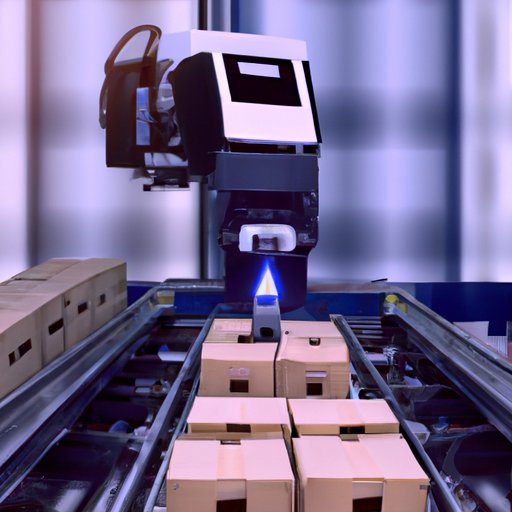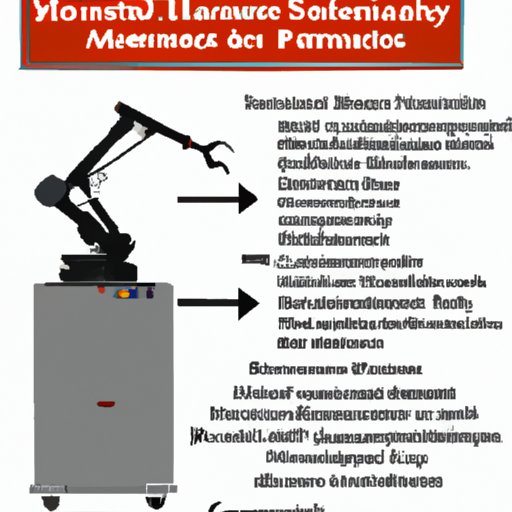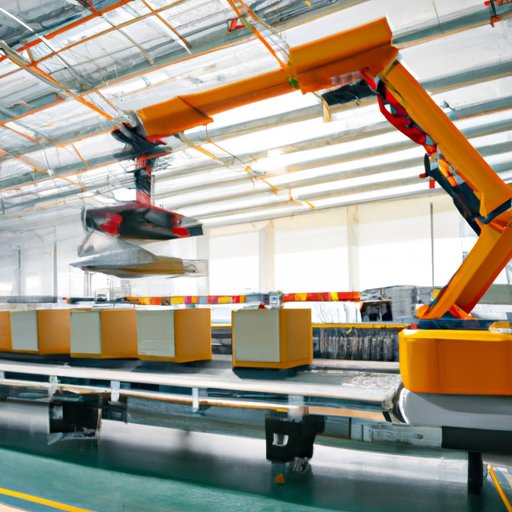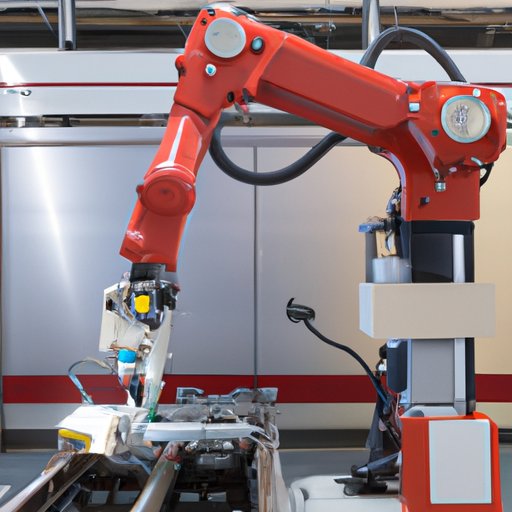Introduction
An automated material handling system is a system that automates the transportation, storage, and retrieval of materials to increase efficiency, accuracy, and safety in a warehouse or manufacturing facility. It is composed of several components, such as conveyors, robots, and automated storage and retrieval systems (AS/RS). The purpose of this article is to explore the different aspects of automated material handling systems, including their benefits, how they work, which industries benefit from them, the different types of systems, safety considerations, and cost-benefit analysis.

Exploring the Benefits of Automated Material Handling Systems
Automated material handling systems offer several advantages over manual processes. These include increased efficiency, lower labor costs, improved safety, and reduced errors and waste.
Increased Efficiency
Automated material handling systems can significantly improve the efficiency of a warehouse or manufacturing facility. With the use of automation technology, materials can be transported quickly and accurately to the desired location. This eliminates the need for manual labor and reduces the time spent on tasks such as loading and unloading trucks, sorting and storing materials, and retrieving items from storage. In addition, automated systems can be programmed to track inventory levels and alert managers when stock needs to be replenished.
Lower Labor Costs
The use of automated material handling systems can reduce the amount of labor required in a warehouse or manufacturing facility. By automating certain tasks, fewer workers are needed to complete the same amount of work. This can lead to significant cost savings, as labor is typically one of the largest expenses for businesses.
Improved Safety
Automated material handling systems can also help to improve safety in the workplace. By reducing the need for manual labor, there is less risk of workers being injured due to overexertion or accidents. Automated systems can also be programmed to follow safety protocols, such as avoiding hazardous areas or shutting down if something is out of place.
Reduced Errors and Waste
Automated material handling systems can help to reduce errors and waste in the warehouse or manufacturing facility. By eliminating manual processes, the risk of human error is greatly reduced. Automated systems can also be programmed to reduce the amount of material wasted by ensuring that only the necessary amount of material is used for each task.
How Automated Material Handling Systems Work
Automated material handling systems are composed of several components, including automation technology, human-machine interaction, and multiple components that work together to move materials throughout the facility. To understand how these systems work, it is important to first look at the different components.
Overview of Different Components
Automated material handling systems typically consist of conveyor belts, robots, and automated storage and retrieval systems (AS/RS). Conveyor belts are used to move materials from one point to another, while robots are used for more complex tasks such as picking and packing items. Automated storage and retrieval systems are used to store and retrieve materials from designated locations.
Automation Technology
The automation technology used in automated material handling systems includes sensors, controllers, and software. Sensors detect changes in the environment and provide feedback to the system, while controllers process the data and control the system’s operations. Software is used to program the system and to monitor its performance.
Human-Machine Interaction
In addition to automation technology, automated material handling systems also require human-machine interaction. Humans are responsible for programming the system and monitoring its performance, as well as troubleshooting any issues that may arise. Humans must also ensure that the system follows all safety protocols and is properly maintained.
What Industries Benefit from Automated Material Handling Systems?
Automated material handling systems are used in a variety of industries, including manufacturing, logistics, and warehousing. In manufacturing, automated material handling systems can help to increase efficiency and reduce labor costs. In logistics, they can help to streamline the shipping and receiving process. And in warehousing, they can help to reduce errors and improve inventory management.
Understanding the Different Types of Automated Material Handling Systems
There are several different types of automated material handling systems, each of which has its own advantages and disadvantages. The most common types are conveyor systems, robotics, and automated storage and retrieval systems (AS/RS).
Conveyor Systems
Conveyor systems are the most basic type of automated material handling system. They are used to move materials from one point to another, and can be configured to transport items of various sizes and weights. Conveyor systems are typically used in manufacturing and warehousing applications.
Robotics
Robotics are more complex than conveyor systems and are used for more complex tasks such as picking and packing items. Robotic arms can be programmed to perform repetitive tasks with precision and accuracy, which makes them ideal for manufacturing and warehousing applications. However, they are more expensive than conveyor systems and require more maintenance.
Automated Storage and Retrieval Systems (AS/RS)
Automated storage and retrieval systems (AS/RS) are used to store and retrieve materials from designated locations. These systems are often used in warehouses and distribution centers, as they can increase efficiency and reduce errors. AS/RS systems can be programmed to move items to specific locations and to keep track of inventory levels.

Automated Material Handling System Safety Considerations
When implementing an automated material handling system, it is important to consider safety. A thorough risk assessment should be conducted to identify potential hazards and develop strategies to minimize them. Additionally, workers should be trained on how to safely operate the system, and proper maintenance protocols should be established to ensure the system is functioning correctly.
Cost-Benefit Analysis of Automated Material Handling Systems
When deciding whether or not to invest in an automated material handling system, it is important to conduct a cost-benefit analysis. This will help to determine the initial investment, long-term savings, and return on investment. Factors to consider include the cost of the system, labor costs, and potential savings from increased efficiency.

Improving Efficiency with Automated Material Handling Systems
Automated material handling systems can help to improve efficiency in the warehouse or manufacturing facility. By automating repetitive tasks, the time spent on these tasks can be reduced. In addition, automated systems can be programmed to streamline processes, resulting in enhanced productivity.
Conclusion
Automated material handling systems offer several advantages, including increased efficiency, lower labor costs, improved safety, and reduced errors and waste. They are used in a variety of industries, including manufacturing, logistics, and warehousing. There are several different types of systems, each of which has its own advantages and disadvantages. When investing in an automated material handling system, it is important to consider safety, cost-benefit analysis, and how it can improve efficiency. Overall, automated material handling systems can be a valuable asset to any warehouse or manufacturing facility.
(Note: Is this article not meeting your expectations? Do you have knowledge or insights to share? Unlock new opportunities and expand your reach by joining our authors team. Click Registration to join us and share your expertise with our readers.)
